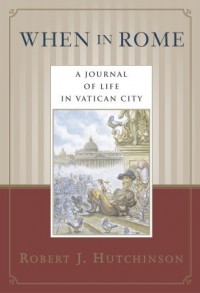All those naked women.

“Like most Catholics, I spent most of my life knowing practically nothing about the Vatican, despite twenty years writing, off and on, about religion in general and the Catholic Church in particular.” When in Rome is Hutchinson's remedy to that deficiency, a delightful romp through the mores and politics of the Holy See.
It's ironic that being a Catholic you get to see a lot of beautiful naked women. "It's true. You may never have realized it before. I never could understand why thickheaded, drooling Protestants would accuse us of being prudes when they gave the world the Puritans and the Moral Majority and we gave the world Rodin's The Kiss.'The fact is that everywhere you go in the Vatican you find nudity. From the Sistine Chapel to the papal apartments are busty young women and tumescent young men in murals and paintings that would cause an immense ruckus if found on the walls of any university or public library.
Hutchinson set out to write a book about the Vatican that would answer the kinds of questions that tourists might ask, e.g. How much do cardinals make? or Where do prelates buy their clothes? He soon learned that the Vatican is still very tight lipped and secretive. In fact, they distrust book writers more than magazine journalists, because threatening to deny them future access can control those who write for periodicals. Book writers, on the other hand, often write only one. And "reporters are trained to expect politicians to lie to them, but even politicians will tell you something, if only so they don't look as though they are covering things up. But avoid expressing an opinion about any person, place, or thing, unless absolutely necessary to further one's own interests. This timidity breeds an atmosphere of secrecy and paranoia that outsiders find pathological but which curial insiders believe to be the noblest kind of discretion." This means a reluctance to respond concretely to questions leading to this type of fictitious response from a cardinal who has been asked if the sky is really blue. 'The issue is not perception as such, but whether the apparent blueness of the sky to some people, at certain times and under certain conditions, reflects what they are actually perceiving or merely what they appear to be perceiving. You can't, on this basis alone, simply make the bare assertion that the sky is blue. It's a very complex question, one on which many experts disagree." At this point, you begin to develop a throbbing headache at the base of the skull.
The Vatican State as we know it today is of very recent origin. Until the mid-nineteenth century, the Papal States covered territory in Italy the size of Denmark. Rome and the Vatican were protected by foreign nations, notably France, until the Franco-Prussian War, when all the French troops were withdrawn from Italy and the Italian nationalists attacked and conquered Rome, in effect, imprisoning the pope in the Vatican. In 1929, Mussolini codified the uneasy truce, and Vatican City became recognized by international law. A second treaty was formalized only as late as 1985. Despite the pope's perpetual support for democratic nations, the church is a highly structured monarchy. The pope's the boss, no doubt about it. He answers to no one - at least no one who's willing to show him/herself politically. Still, every day at noon, a cannon is fired to celebrate the Italian victory over Rome and the pope.
Hutchinson's book is filled with delightful little pieces of information such as how the Swiss guard uniforms were designed, how many uniforms have to be tailored, the contents of the Vatican library, and most interestingly his tour through the secret archives that contain documents of extraordinary historical value. "The dominant trait [of the Curia and Vatican staff] is circumspection - the ability to documents of extraordinary historical value. "The Secret Archives is also responsible for the Vatican's overseas diplomatic missions as well as the staggering amount of material that is received directly from the 2,700 metropolitan sees, 212,000 individual parishes, heads of states, scientific organizations, non-Catholic religious bodies, cultural leaders, and so on. The sheer amount of paper that washes over the Vatican. . . boggles the mind."
The Vatican has been responsible for many scientific discoveries and we owe our calendar to Pope Gregory who- in order to correct errors of the Sosigenean calendar that was off by eleven minutes and fourteen seconds per year- simply declared in a 1582 Papal bull that the day after October 5 would officially become October 15 and that the year would now be 365.2422 days long, making the calendar off only 3.12 days every 400 years. Hence leap years. It was from the Meridian Room (more naked cherubs on the ceiling) atop the tall Tower of the Winds built by Gregory that the astronomical observations were made to provide the corrections.
The story of Queen Christina of Sweden, her abdication and conversion to Catholicism, is fascinating. Particularly as she scandalized Rome by her licentious behavior - she was a flagrant lesbian, and the story of how she came to be buried with the popes reveals a great deal about how attitudes have shifted in the past few centuries.
This is a delightful little volume that makes want to grab the next flight to Rome to indulge in the majesty and glory of living history.












